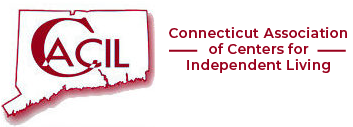Properly fund Connecticut’s Independent Living Centers
CT’s 5 Centers seeking $1 million in additional funding in FY 26 & 27
Connecticut’s fiscal health is the strongest it has been in a generation.
A funding increase would begin to make vital services available again in every town and city in our state.
Connecticut’s Independent Living Centers (ILCs) are non-residential community-based organizations, established by the federal Rehab Act in 1973 and expanded with additional state funding in 1987 to serve all 169 of the state’s municipalities.
Funding for Independent Living Centers has not kept up with inflation for decades, limiting the centers’ ability to provide services to the 600,000 people in Connecticut who identify as having a disability – any disability and of any age.
While the ILCs have received some increases, our current funding is $1.025 million, only $205,000 per center. After 36 years of almost stagnant funding, the Centers remain 35 percent behind inflation. As a result, the Centers have been forced to reduce service areas.
What is the mission of ILCs?
Independent Living Centers, whose staff is at least 51 percent people with disabilities, empower other people with any disability to live, work and thrive in the community, providing five federally-required core services:
- Information and referral;
- Peer counseling;
- Individual and systems advocacy;
- Independent living skills instruction;
- Transition services for youth-to-adult and out of nursing facilities. (including Money Follows the Person)
The centers also assist people to obtain or maintain housing and employment, making all services available to people who are deaf or hard of hearing with dedicated staff who are fluent in ASL.
The Centers’ goal is to provide consumers with the support, training, education and tools they need to live independently and to fully participate in their communities.
The Most Recent Statistics
The ILCs conducted a weeklong utilization survey of the five Centers and report the following findings:
- The 53 full and part-time staff at the five Centers, working a 35-hour week, had a total of 1,530 available working hours during that week and served 243 consumers.
- Centers operated at or beyond capacity, logging performance of services between 95 and 104 percent of available hours.
- Work performed in three general areas breaks down as follows:
- Direct consumer services: 54%
- Community activities: 12%
- Administrative 34%
- The five Centers’ service areas broke down as follows. Out of 169 municipalities in Connecticut:
- 20 municipalities – no consumers received services;
- 95 municipalities – fewer than 10 people received services;
- 5 urban areas – served 906 consumers.
- Every Center has waiting lists for services, including a list of 48 people at one Center waiting for HIV-related housing support.
Flat funding would be devastating in light of the extreme uncertainty around federal funding, and existential challenges to our mission to hire people with disabilities to help other people with disabilities.
Increase funding for Connecticut’s five Independent Living Centers by $1 million to protect vital services.
- To fully fund statewide services, the ILCs would need more than $5 million. Our request for $1 million would begin to address long term underfunding and support our ability to provide services to as many people as possible.
- $1 million = $200,000 for each Center. That would bring total state funding for each of the five centers to $405,000.
- Additional funding would support vital services and begin to restore long term underfunding.
- Connecticut’s fiscal health is good. The state can afford to support vital services.
At $1M Connecticut provides the lowest amount of state funding
compared to adjacent states.
Connecticut
$1,000,000
New York
$13,360,999
Massachusetts
$7,146,117
Rhode Island
$302,560
(has only one CIL)
In 2016, the State Independent Living Council, a Governor appointed body, commissioned a US Census data-driven funding formula developed by the Indiana Business Research Center. The report concludes that $5.5 million is the true cost to fully fund CT’s ILCs, permitting them to meet the needs in the state, with a base level of state funding of $550K per center.
Services provided by Connecticut’s five Independent Living Centers help individuals live the lives they desire and deliver a substantial return on public investment.

